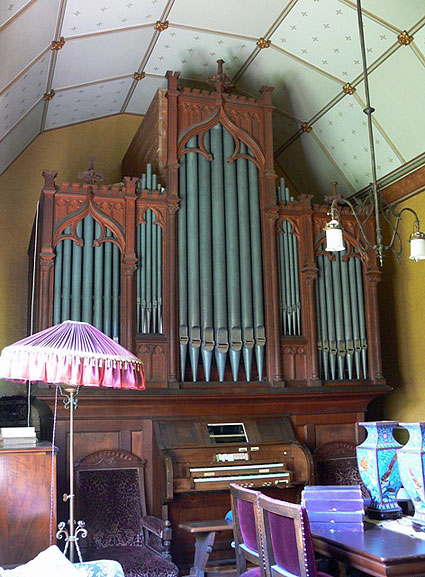
The Walcker organ in its present location in Ballarat
[Photograph by John Maidment (December 2008)]

The Walcker organ in its present location in Ballarat
[Photograph by John Maidment (December 2008)]
Historical and Technical Documentation by Geoffrey Cox
© OHTA 1989, 2011 (last updated August 2011)
This organ was built by E.F. Walcker & Co., Ludwigsburg-Würrt, Germany in 1911 as the firm's opus 16361 for St Andrew's Lutheran Church, Brisbane. This small brick and stone-veneer church, dedicated as 'St Andreas,' had been opened in 1882 and was slightly enlarged in 1911, the year in which the Walcker organ was added.2
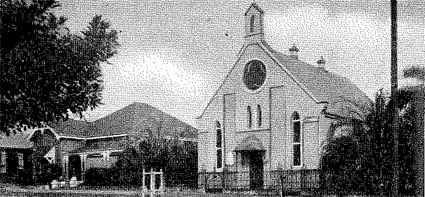
St Andreas Church, Wickham Terrace, Brisbane
[Photograph from F. Otto Theile, One Hundred Years of the
Lutheran Church in Queensland (1938), p. 186]
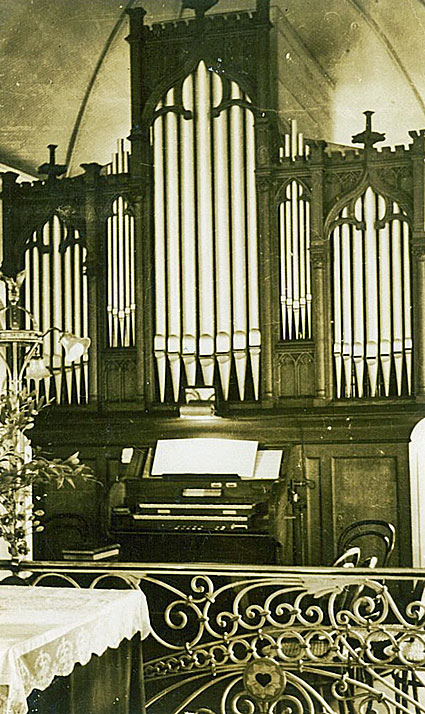
The 1911 Walcker organ in the former St Andrew's Church
[Photograph supplied by Sigfried Monz, c.1974]
Following the merger in 1975 of the St Andrew's congregation with that of the nearby Bethlehem Lutheran Church, Fortitude Valley, a new church was opened at Wickham Terrace in 1976, and the Walcker organ was installed in the gallery.3 There it remained until 1990, when it was removed to storage in Melbourne by Knud Smenge. It was installed by the present owner in its present location, a specially designed music room with lofty Gothic ceiling, between 1999 and 2002.4
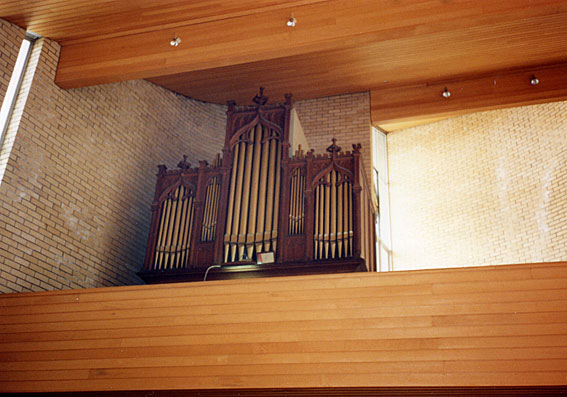
The Walcker organ in the new church at Wickham Terrace
[Photograph by Howard Baker (October 1989]
This organ was one of two exported by the Walcker firm to Queensland, the other being a much smaller one for St John's Lutheran Church, Bundaberg, in 1898. The firm had earlier exported five instruments to New South Wales between 1861 and 1887, including those now at St Stephen's Anglican Church, Mittagong, the Residence of Peter McMillan, Glenorie, St Paul's Anglican Pro-Cathedral, Hay, and St Paul's Lutheran Church, Sydney.5 The Brisbane instrument was significantly later than these, dating from the period in the firm's history when Oscar Walcker, the grandson of Eberhard Friedrich Walcker, had begun to be influenced by ideas from the Alsatian Organ Reform Movement, which was headed by Dr Albert Schweitzer.6
Since being installed in Ballarat, the pipework of the instrument has been regulated back to the original wind pressure by Wakeley Pipe Organs of Melbourne, the leatherwork has been renewed, and the roll-playing mechanism (termed 'organola') has been restored. This utilizes 58-note rolls, which operate the keys of the instrument but not the stops. Registration and dynamics have to be controlled manually.7


The console of the Walcker organ,
including controls for the roll-playing mechanism
[Photographs by John Maidment (December 2008)]
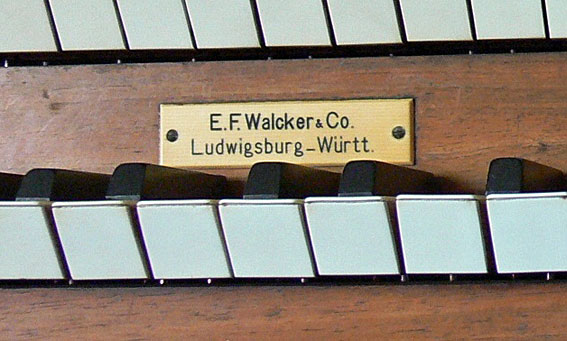
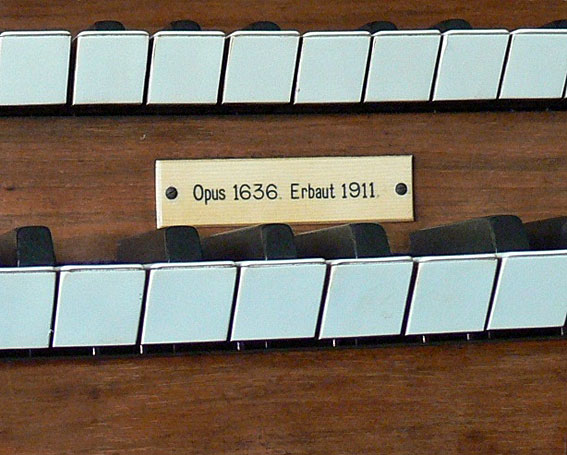
The builder's plates, unusually split into two
[Photographs by John Maidment (December 2008)]
Apart from the Principal 8ft, which is placed in the façade, all of the pipework is enclosed. The pipes above 4ft are all of metal, and cone tuning has been retained. The Gothic casework is in oak and incorporates the zinc pipes of the Principal 8ft. These had previously been covered in gold paint, which has been removed to reveal the original finish. The instrument has a very bright and characterful sound.8
This organ is significant as an example of the work of E.F. Walcker & Co. in Australia that has not been significantly altered and which has been restored with all the original features intact.


Restored casework and façade pipes
[Photographs by John Maidment (December 2008)]

Metal pipes, retaining cone tuning
[Photograph by John Maidment (December 2008)]
The specification is as follows:
| MANUAL I Principal Flauto amabile Dulciana Octav Mixtur MANUAL II Flöte Dolce Gamba Voix céleste Rohr-flöte PEDAL Bourdon COUPLERS Sub II z I II z Ped I z Ped II z I Basskoppel |
8 8 8 4 2-2/3 fach 8 8 8 8 4 16 |
A B A B A |
[unenclosed] [3 ranks, 15.19.22] (operated by pistons beneath the lower manual) [Melodic bass coupler, Pedal to Manual I] |
Tutti
Organola an [on/off]
Speed control for organola
Tracking control for organola
Wind indicator window
Compass: 58/27
Attached stop-key console
Balanced swell pedal (mechanical)
Couplers & accessories operated by hitch-down thumb pistons
Pedalboard: flat & straight
Tubular-pneumatic action.9

Original drawings for the organ by E.F. Walcker & Co.,
marked 'Brisbane Op 1636'
[Photograph by John Maidment (December 2008)]
______________________________________________________________________________
1 Builder's plate on the console, noted by G. Cox, 1974.
2 Siegfried Monz, A Brief History of St Andrew's Church, Wickham Terrace, Brisbane 1858-1984 (unpubl. booklet, c.1988).
3 The Sunday Mail Colour Magazine (13 June 1976), pp. 24-25.
4 Dates supplied by John Maidment, 1990 and 2008.
5 Graeme Rushworth, Historic Organs of New South Wales: The Instruments, Their Makers and Players, 1791-1940 (Sydney: Hale & Iremonger, 1988), pp. 331-33, 428.
6 'The House of Walcker: A Brief Historical Survey,' available at www.walckerorgel.de ©2006 – accessed 4 August 2011.
7 Observations by John Maidment, December 2008.
8 Observations by John Maidment, December 2008.
9 Specification noted by G. Cox, September 1974, and John Maidment, December 2008.